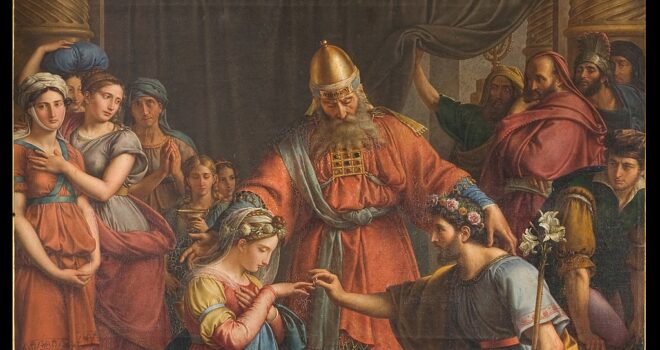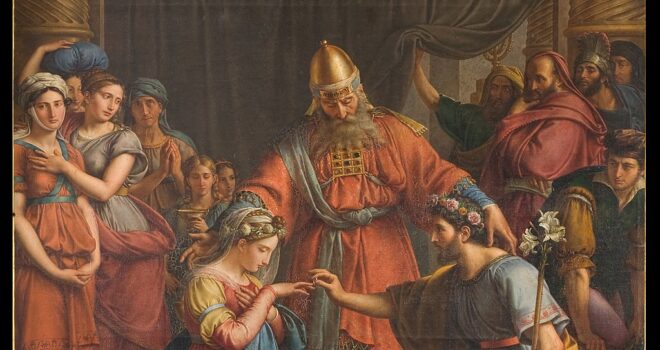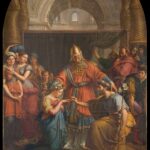A Catholic priest and convert from Anglicanism, Ronald Knox was one of the most famous preachers in England in the decades surrounding the Second World War. Quite the eccentric, Knox’s linguistic brilliancy manifested itself from his earliest years when, as a middle schooler, he was writing serial stories for a Latin newspaper he created with his siblings. Schooled at Eton and Balliol, Knox converted to Catholicism from the ranks of the Anglican clergy in 1917 and was quickly ordained to the Catholic priesthood: he eventually went on to create the “Knox Bible”, an entirely new translation with the distinctive flair of semi-archaic and unusual wording.
Throughout his life, Knox was in high demand as a preacher. Once he got tired of re-using a sermon for the same occasion (graduations, weddings, etc), he would publish it and take it out of circulation. One such collection is Bridegroom and Bride, a slim volume of wedding homilies recently republished by Cluny Media, which has republished a number of his books. A pithy and wise book, Knox’s homiletic admonitions to newlyweds form a small treasury whence insights “both new and old” can be drawn.
Like his close friend Hubert van Zeller (another of my favorite authors), Knox writes that true romantic love is a matter of “give and give”, not “give and take”: “The cynic will tell you that married happiness is a matter of give and take. Do not believe him; it is a matter of give and give.” The bride and groom “minister the sacrament to one another, not so much by accepting” the gift of the other so much as by “standing there in silence and making, each in turn, the gift that is being accepted.”
Knox waxes lyrical on the symbolism of the ring in several lovely passages: “You two have accepted that Christian duty, within the narrow circle of which the wedding ring is the symbol.” And:
Here is another beautiful statement of how marriage reflects the nature of God in man: God is a communion of persons, and to be “in God’s image” is to be ordered to a communion of persons as well.
Because we wear God’s image, it is not natural for man to be alone; it is natural that man should say to woman, “I thee wed, I thee worship, I thee endow, in the name of the Father and of the Son and of the Holy Ghost, Amen.”
Though there is a vocation to celibacy within Christianity, nonetheless “it is natural for man or woman to look out on a world-picture framed in a human companionship; we see better, don’t we, with two eyes than with one?”
This natural attraction is rightly felt on several levels:
Just as you cannot say with confidence, “Here body ends and soul begins,” you cannot say with confidence, speaking of two lovers, “Here was a physical, and here was a spiritual attraction.” The two threads are intertwined.
This basis in nature is elevated, not supplanted by the grace of the sacrament. “Grace,” writes Knox, “is not something that comes in from the outside, and says, ‘No, you are doing it wrong, let me show you how to do it.’” Rather, “it perfects nature, transmutes something that belongs to earth and makes it glow with the radiance of heaven.” The love felt “is already something sacramental,” “raw material” which is “waiting for the divine action to polish it.” How reassuring for Knox to tell us that “Divine and human love are not strangers to one another, are not forces pulling in different directions.” As Knox’s confessor and close friend Dom Hubert says in We Live With Our Eyes Open:
Bring God to love? But He is already there. God is love; human love is simply one side of it stretching out to the other. Human love is meant to tell us something of Divine love. This is primarily what it is for. To get the love of God right, we have only to learn the lesson from human love.
Bridegroom and Bride is not a theological treatise on marriage. It is not a self-help book. It is a set of simple meditations, short vignettes on different aspects of Christian romance and the ceremonies that ratify it and make it a sacrament. Thought provoking without being an intellectual tour-de-force, Knox reminds us of “commonplace truths,” which “because of our human frailty” often obscured. First and foremost, it is a reminder that romantic love is part of God’s plan for humanity, and that He intends to support, increase, and beautify it through the sacrament of marriage. “Your love grow less?” asks Knox. “Not while it is fed by the power that multiplied the loaves, and turned water into wine. Incarnate Christ does not fail to take all that is most human in us and divinize it.”
Image: The Espousal of the Virgin by Jean-Baptiste Wicar












